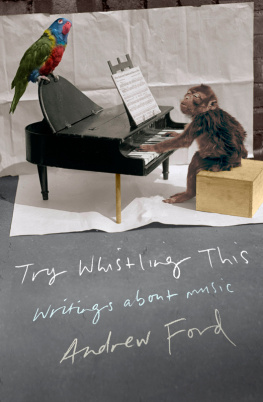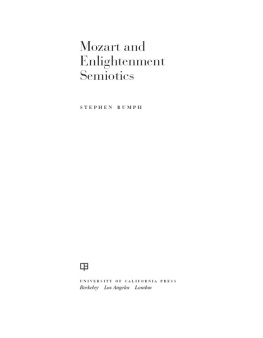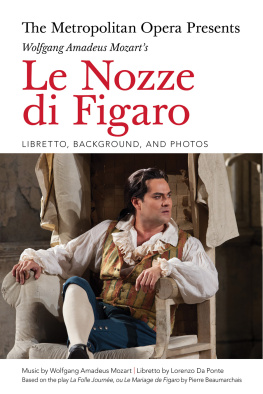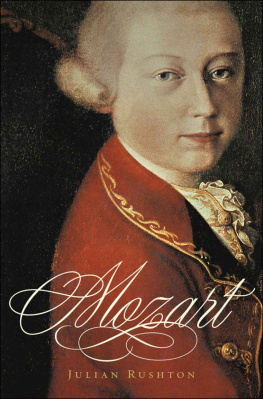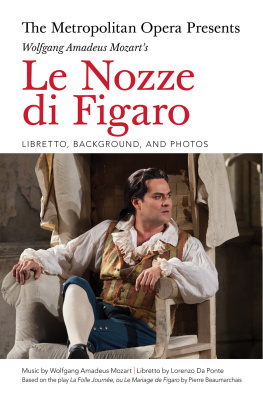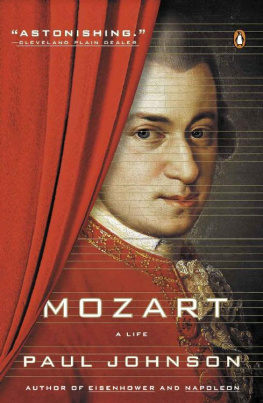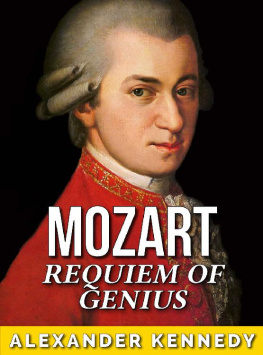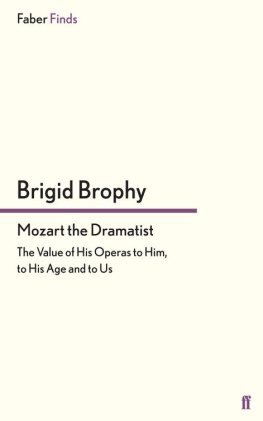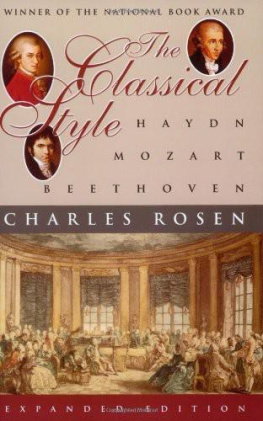MUSIC, SEXUALITY AND THE ENLIGHTENMENT IN MOZARTS FIGARO, DON GIOVANNI AND COS FAN TUTTE
Music, Sexuality and the Enlightenment in Mozarts Figaro, Don Giovanni and Cos fan tutte
CHARLES FORD
Institute of Musical Research, University of London, UK

First published 2012 by Ashgate Publishing
Published 2016 by Routledge
2 Park Square, Milton Park, Abingdon, Oxon OX14 4RN
711 Third Avenue, New York, NY 10017, USA
Routledge is an imprint of the Taylor & Francis Group, an informa business
Copyright Charles Ford 2012
Charles Ford has asserted his right under the Copyright, Designs and Patents Act, 1988, to be identified as the author of this work.
All rights reserved. No part of this book may be reprinted or reproduced or utilised in any form or by any electronic, mechanical, or other means, now known or hereafter invented, including photocopying and recording, or in any information storage or retrieval system, without permission in writing from the publishers.
Notice:
Product or corporate names may be trademarks or registered trademarks, and are used only for identification and explanation without intent to infringe.
British Library Cataloguing in Publication Data
Ford, Charles (Charles C.)
Music, Sexuality and the Enlightenment in Mozarts Figaro, Don Giovanni and Cos fan tutte.
1. Mozart, Wolfgang Amadeus, 17561791. Operas. 2. Mozart, Wolfgang Amadeus, 17561791. Nozze di Figaro. 3. Mozart, Wolfgang Amadeus, 17561791. Don Giovanni. 4. Mozart, Wolfgang Amadeus, 17561791. Cos fan tutte. 5. Opera18th century. 6. Sex in music. 7. MusicSocial aspects.
I. Title
782.1092-dc23
Library of Congress Cataloging-in-Publication Data
Ford, Charles (Charles C.)
Music, Sexuality and the Enlightenment in Mozarts Figaro, Don Giovanni and Cos fan tutte / Charles Ford.
p. cm.
Includes bibliographical references and index.
ISBN 978-0-7546-6889-3 (hardcover : alk. paper) ISBN 978-1-3155-9692-1 (ebook) 1. Mozart, Wolfgang Amadeus, 17561791. Nozze di Figaro. 2. Mozart, Wolfgang Amadeus, 17561791. Don Giovanni. 3. Mozart, Wolfgang Amadeus, 17561791. Cos fan tutte. 4. Sex in music. 5. Opera18th century. I. Title.
ML410.M9F7263 2012
782.1092dc23
2011035398
ISBN 9780754668893 (hbk)
ISBN 9781315596921 (ebk)
ISBN 9781317091561 (ebk-ePUB)
Bach musicological font developed by Yo Tomita
Contents
List of Figures and Tables
Figures
Tables
List of Music Examples
Notes on the Text and Acknowledgements
Notes on the Text
1. This book builds upon and expands my earlier book, Cos? Sexual Politics in Mozarts Operas (Manchester University Press, 1991).
2. The music examples are collected at the back of this book for ease of reading.
Acknowledgements
I would like to thank my very good friends Eric Clarke, Paul Davies and Allan Moore for their long-term intellectual and personal support. I am also grateful to Richard Emsley for his superb transcription of the musical examples, and to my nephew, Christopher Preston, for .
This book is for my wife, Lucy Green, not as a dedicatee or as recipient of a gift, but, far more significantly, as its primary addressee. She has been involved in every stage of this project from 1980; and it is for her, primarily, that I have always been writing: her voice in my imagination that says, You cant say that! or OK, thats better, even Excellent!. Moreover, she has given the support, encouragement and constant intellectual stimulation without which this book would not be in your hands. I am immensely grateful.
PART I
Overtures
Chapter 1
Introduction
The Project
This book interprets Mozarts music for Le nozze di Figaro (1786), Don Giovanni (1787) and Cos fan tutte (1790) in terms of the ideas of their time, the Enlightenment, with particular reference to questions of sexual identity, desire and ethics. The Anglo-French Enlightenment can be roughly dated from Englands Glorious Revolution of 1688 to the 1789 French Revolution. The literature, plays, novels, paintings and music of this period follow a roughly marked track, veering more or less coherently from seventeenth-century rationalism towards nineteenth-century idealism. Broadly speaking, the Anglo-French Enlightenment changed course in mid-century, and, having been completely opposed to the ideas of its very different German equivalent, the Aufklrung, tended more towards the latters emphasis on the feelings and the creative subject.
These two sectors of the European Enlightenment were in collision in 1780s Vienna, which resulted in the tremendous literary and musical excitement and fertility of the citys daily life. So it is that whilst the opening of Le nozze di Figaro sounds the Italianate, Rococo style of the Anglo-French Enlightenment the first chord of Don Giovanni sounds the intensity and violence of the German Sturm und Drang.
The Anglo-French Enlightenment used the Classical Roman notion of a sensus communis as the basis for its idea of common sense, implying a body of knowledge, so seemingly immediate and primary as to be unworthy of critical attention. In so doing, eighteenth-century thought established, through scientific and philosophical debate, the axioms and assumptions, the logic and the prejudices of todays common sense. It is because our ideological origins lie in the eighteenth century that we call its music Classical with a big C, despite its fundamentally anti-Classical nature. Enlightened music is more appropriate.
So, because of this continuity of common sense from the Enlightenment to today, studying the Enlightenment can provide a purchase on todays assumed common sense. Similarly, to analyse these exceptionally rich examples of Enlightened music does not involve separating oneself off as a subject now who is completely divorced from an historical object then, but requires delving down into this, the continuity of Enlightened, diatonic, nonconceptual common sense from then to now. Whilst the focus of this book is on music, and then usually on its fleeting moments, it is always with constant regard to the social-historical whole. So the underlying method here is both interdisciplinary and micro-holistic.
The book is divided into five Parts: Overtures, Masculine Music, Feminine Music, Seductions and Finales.
gives an account of the Anglo/Scottish-French Enlightenment, and interprets the overtures of the three operas in these terms.
presents the case for a masculine musical sub-style. After a chapter about changes in Enlightenment thought, the German Aufklrung and the ideological complexities of Vienna at this time, I discuss the music of the lyric tenors: Ottavio in Don Giovanni and Ferrando in Cos fan tutte. In this context I also venture into Die Zauberflte to discuss Taminos first aria.
concerns the music of the leading female roles, and the apparent contradiction between womens absence from Enlightenment philosophy, and their musical foregrounding in these operas.
begins with analyses of the, musically, relatively simple seductions. Then, after introducing emergent idealist philosophies of music in the latter part of the eighteenth century, I discuss the musically far more complex and dynamic sexual relationship between Fiordiligi and Ferrando in
Next page

